Dogs With Children: How To Make It Work
By Michele Welton, Dog Trainer, Breed Selection Consultant, Author of 15 Dog Books
In this article, I cover:
- Getting a dog "for the kids"
- How often dogs bite children
- How to keep kids from being bitten by your dog
- Choose a child-friendly dog
- Raise your dog properly
- Raise your KIDS properly
- Older children and dogs
- Infants and dogs
Getting a dog "for the kids"
The plan here is that the kids will come home from school and take the dog for a nice long walk and then outside to play.

The problem is that most children don't interact with a dog in ways that encourage good habits. They don't create good routines. They don't avoid bad routines. They don't add rewards to good behavior. They don't correct bad behavior. Not consistently, anyway.

Not good lessons for the pup (or the child) to be learning here!
In fact, often children (unintentionally) undermine your attempts to raise the pup to be well-behaved.
Children tend to see dogs as furry playmates and will encourage the pup to do all sorts of undesirable things:
- Children will wrestle with the dog, inciting him to struggle against them.
- They'll let the dog pull on the leash and jump on them.
- They'll run away from the dog, inciting him to chase and nip.
- They'll stamp their foot playfully at the dog, inciting him to bark.
Mind you, none of this is done with bad intentions! Children who are having fun simply can't judge when a dog is out of control and they can't correct a dog with enough authority when his behavior does go over the line.

More bad routines being ingrained here.
Similarly, dogs often view children as littermates. Dogs jump on children, grab things away from children, nip, chase, and play roughly, just as they would play with another dog.
Dogs don't view children as leaders, or even potential leaders, to be respected – not until the child is mature enough to follow the instructions in my training articles. Obviously that age varies, but typically it won't be until age 10 or so.
You need to look at your children as honestly and objectively as possible. Are they mature enough and responsible enough to follow your rules of handling the dog? If you tell them not to do something with the dog, will they stop doing it? How consistently? a solid 95% of the time? or only 50%?
Younger children simply cannot follow my training program, so they should not be allowed to interact with the dog unless you are right there supervising.
Older children who cannot (or worse, will not) follow my training program should also not be allowed to interact with the dog unless you are right there supervising.
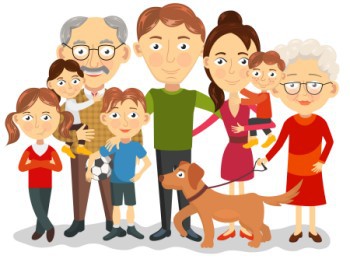
But it's not just the dog's behavior you need to monitor – it's the kids' behavior too. Some owners seem to think that it's entirely up to the dog to change his jumping or nipping behaviors... even when the kids are egging him on.
That isn't realistic or fair. Kids need to be taught what they are (and aren't) allowed to do, just as much as dogs do.
If one or more of your kids can't or won't follow your instructions even when you're right beside them, the dog should be off limits until the child matures.
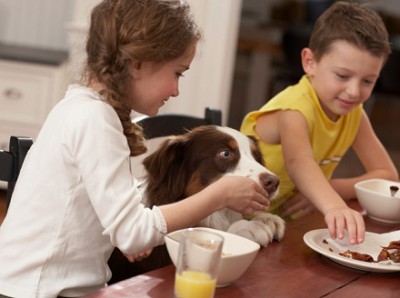
Both the dog and the kids are having a good time, sure, but the dog is learning bad habits.
I realize this will be a great disappointment to parents who got the dog for the kids. And I'm sorry for needing to say it.
But a dog is a living sponge who will soak up all the undesirable things that children allow him to do.
In addition, when kids do the things that kids naturally tend to do, some dogs may react with... a bite.
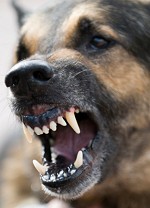
How often dogs bite children
Regrettably, it's time for a few statistics:
- In the United States alone, 4.7 million people each year are bitten by a dog. 800,000 of them require medical treatment, 10,000 are hospitalized, and about 40 people die.
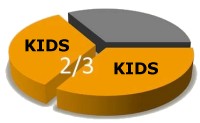
- About two-thirds of bite victims are children, mostly under the age of 12.
 70% of bite injuries to kids under age 10 are bites to the face, often damaging the eyes or requiring major reconstructive surgery. Some children, including sleeping infants, are killed by dogs.
70% of bite injuries to kids under age 10 are bites to the face, often damaging the eyes or requiring major reconstructive surgery. Some children, including sleeping infants, are killed by dogs. Over 50% of bitten children are bitten by the family's own dog. Another 25% are bitten by a dog owned by a friend or relative. So even though we tell our kids, "Never pet a strange dog," the much more serious threat is inside our own home or over at the neighbor's.
Over 50% of bitten children are bitten by the family's own dog. Another 25% are bitten by a dog owned by a friend or relative. So even though we tell our kids, "Never pet a strange dog," the much more serious threat is inside our own home or over at the neighbor's.
I've been working with dogs for many decades and I respect their strong jaws and teeth. I hope you'll have that kind of healthy respect as well.
Why dogs bite children
Dogs may not always know that a young child is human.
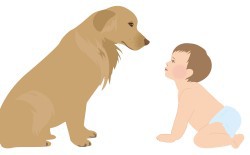
This dog may be thinking, "What the..? Crawling critter?? Smells bad... did you go potty? Whatever you are, you're gonna get in trouble for that!"
You and I see children as human beings who are simply younger and smaller than adults. But some dogs appear puzzled by very young children and may not recognize them as human beings.
Young children move their arms and legs with unpredictable, herky-jerky movements. Young children bump into things, drop things, knock things over. They trip and fall. They jump up and down, hit and kick things, yell and cry in high-pitched voices.
You might protest, "But my child is different!"
It's perfectly natural to believe that your child is different from other children, that your child will behave just fine around any dog.
But it's not how YOU see your child that counts. It's how a DOG sees your child that counts. And from a DOG'S perspective, the vast majority of children ARE much the same.
Their tone of voice, their facial expressions, the way they move their arms and legs.... it is NORMAL child-like behaviors that can trigger a growl or a bite.
From the perspective of some dogs, a toddler or young child may appear to be a mystifying creature, an altogether different creature than you are.
How to keep kids from being bitten by your dog
- Choose a dog who is good-natured and friendly.
- Raise the dog properly.
- Raise your kids properly.
Short and sweet, that's it. For more details, keep reading!
First, choose a dog who is good-natured and friendly.
How can you predict a dog's temperament?
Well, you can't guarantee it, but you can predict it (with more or less reasonable accuracy) by temperament-testing.
- If you're getting an adult dog, do temperament tests on him before agreeing to adopt.
- If you're getting a puppy, do temperament tests on both the pup AND the parents.
I'm planning an article on temperament-testing, but for now you can find decent canine temperament tests on other sites.
When you have kids under age 10 (or thereabouts), it is safest to...
![]() Avoid dogs who are shy, sensitive, or easily startled – they will have a low tolerance for sudden movements (like a child waving her arms), sudden sounds (a child yelling), roughhousing, even the kind of enthusiastic patting that kids like to do. This describes most toy breeds and many Poodles, Shelties, and sighthounds (fast, slender, long-legged breeds like Greyhounds).
Avoid dogs who are shy, sensitive, or easily startled – they will have a low tolerance for sudden movements (like a child waving her arms), sudden sounds (a child yelling), roughhousing, even the kind of enthusiastic patting that kids like to do. This describes most toy breeds and many Poodles, Shelties, and sighthounds (fast, slender, long-legged breeds like Greyhounds).
Sensitive dogs often become stressed and nervous around small children and may react with a sudden defensive snap.
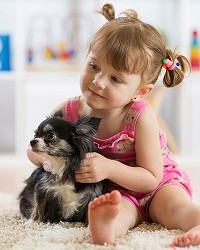
I definitely don't recommend toy dogs, like this Longhaired Chihuahua, for young children.
![]() Avoid tiny dogs (under 10 pounds). First, it's unsafe for the dog. Even when a child means well, a tiny dog can be accidentally stepped on, sat on, squeezed too hard, or dropped. You can supervise them 24 hours a day, but the one day your child plays Speed Racer with his bike will be the day your tiny dog will be in the wrong place at the wrong time.
Avoid tiny dogs (under 10 pounds). First, it's unsafe for the dog. Even when a child means well, a tiny dog can be accidentally stepped on, sat on, squeezed too hard, or dropped. You can supervise them 24 hours a day, but the one day your child plays Speed Racer with his bike will be the day your tiny dog will be in the wrong place at the wrong time.
Second, tiny dogs often become stressed and nervous around small children and may react with a defensive snap if a child suddenly tries to pick the dog up or pat-pat-pat the top of its head. We should appreciate the perspective of a wee little dog who sees a palm suddenly swooping down from the sky... looks threatening, doesn't it?
![]() Avoid feisty or opinionated dogs (most terriers, Dachshunds, Lhasa Apsos, Basenjis, Chow Chows, Australian Cattle Dogs...) who won't put up with nonsense from little life forms that they view as below themselves in importance.
Avoid feisty or opinionated dogs (most terriers, Dachshunds, Lhasa Apsos, Basenjis, Chow Chows, Australian Cattle Dogs...) who won't put up with nonsense from little life forms that they view as below themselves in importance.
![]() Avoid dogs who act aggressively toward other dogs. Fortunately, most dogs who are dog-aggressive are not automatically people-aggressive. But some dogs do have this dual aggression, and for some others, it's only a short hop to becoming so. In addition, you can't safely allow a child to take a dog who is dog-aggressive for a walk.
Avoid dogs who act aggressively toward other dogs. Fortunately, most dogs who are dog-aggressive are not automatically people-aggressive. But some dogs do have this dual aggression, and for some others, it's only a short hop to becoming so. In addition, you can't safely allow a child to take a dog who is dog-aggressive for a walk.
![]()
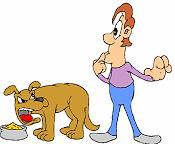 Avoid possessive dogs who guard their food or toys. Any breed can develop this bad habit, but it's especially common in Alaskan Malamutes, Akitas, bulldogs and bulldog-related breeds, and various terrier breeds. Now, no child should approach a dog who is eating or chewing on a bone. But if a child once in a while happened to do so, you wouldn't want a dog who is inclined to lash out. I simply would not keep a food-possessive or toy-possessive dog around a child.
Avoid possessive dogs who guard their food or toys. Any breed can develop this bad habit, but it's especially common in Alaskan Malamutes, Akitas, bulldogs and bulldog-related breeds, and various terrier breeds. Now, no child should approach a dog who is eating or chewing on a bone. But if a child once in a while happened to do so, you wouldn't want a dog who is inclined to lash out. I simply would not keep a food-possessive or toy-possessive dog around a child.
![]() And finally, when you have young children, I don't recommend these breeds:
And finally, when you have young children, I don't recommend these breeds:
- Akita
- American Bulldog
- Boerboel
- Bullmastiff
- Cane Corso
- Caucasian Ovcharka
- Dogo Argentino
- Pit Bull Terrier
- Presa Canario
- Rottweiler
- Tosa Inu
- Wolf-Dog Hybrid
They're all ruled out anyway by my recommendation to avoid dog-aggressive and food-possessive breeds.
But I would also rule them out because there are so many crummy breeders producing these breeds with dangerously unstable temperaments.
Finally, they can do SO much damage if they do bite...
Which breeds DO I recommend for families with kids under age 10?
When I consult with people who are looking for breed selection advice, we discuss family members, lifestyle, home, yard, fencing, other pets, prior experience with dogs, how much grooming and exercise can be provided, etc.
Without that information, there's no carved-in-stone, one-size-fits-all list of breeds I can recommend. And I don't know your particular kids either!
![]() That being said, and with the standard disclaimer that your mileage may vary.... it's hard to beat a good Golden Retriever or Labrador Retriever. My top two GO-TO breeds for families with young children, these retrievers are among the most good-natured, friendly, and stable of all breeds – seldom aggressive toward anyone.
That being said, and with the standard disclaimer that your mileage may vary.... it's hard to beat a good Golden Retriever or Labrador Retriever. My top two GO-TO breeds for families with young children, these retrievers are among the most good-natured, friendly, and stable of all breeds – seldom aggressive toward anyone.
A good German Shepherd can also be great with young children. Unfortunately, it's hard to find a good German Shepherd today. There are so many different "types" and temperaments, so many health problems, so many irresponsible breeders. For example, I would never acquire a German Shepherd today from show lines; I have no faith whatsoever in their temperaments. But if you can find a solid pup from working lines, they can be great.
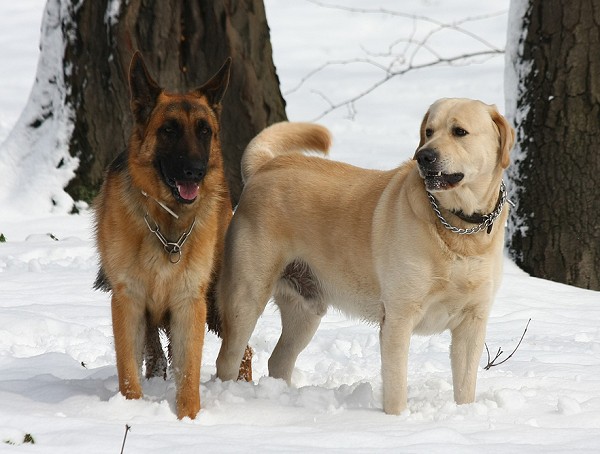
German Shepherds and Labrador Retrievers are solid family dogs. Just be careful where you get them! Read my breed reviews.
But be aware! It's not JUST about the dog's BREED... it's also about the individual dog.
In every breed, there are individual dogs who don't display their breed's typical temperament or behavior. For example, some individual Lhasa Apsos adore children, even though the breed in general... doesn't (to put it mildly).
Always keep in mind that the actual temperament of an individual dog is more important than the expected temperament of the breed in general.
On the other hand, unless you're good at evaluating whether the dog you're looking at has or doesn't have that breed's typical temperament, it might be safer to expect the breed's typical temperament.
There's no doubt about it. When you have children, it's difficult to choose a dog and feel confident that you've chosen the right one.
Let's say you've done the first step: You've chosen a dog who is good-natured and friendly. Now, what should you do next to keep kids from being bitten by your dog?
Second, raise your dog properly.
- Make sure you and your spouse are the leaders in your household. If your dog thinks HE is the leader, he will feel justified in disciplining (biting) a lower-ranking group member (child) who does something the dog doesn't like (touching his paw, for example). That's what can happen if you allow an improper "hierarchy" or "pecking order" to develop in the family.
- Don't allow your dog to practice excitable behaviors such as rough play, jumping on people, or bark-bark-bark-bark-bark. Families with kids need a calm dog. Follow the training program laid out in my articles.
- Maintain your dog's health and grooming so he isn't in any discomfort. A dog who hurts feels irritable and could lash out if a child did something (even accidentally) that made the pain worse. Painful health issues include hip dysplasia, arthritis, bad teeth, matted hair that pulls on the dog's skin, flea allergies that cause the dog to frantically chew his own skin leading to potential infections. So stay on top of your dog's health and grooming!
- Don't tether your dog outside, and don't leave him unsupervised in a yard where he can run up and down the fence barking. Tied-up dogs and fence-runners are more likely to develop frustration and subsequent aggression or reactivity.
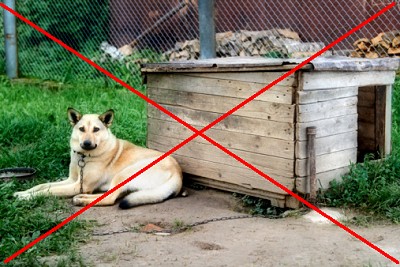
Let's say you've done the first two steps: You've chosen a dog who is good-natured and friendly, and you're raising that dog properly. What's the final thing you should do to keep kids from being bitten by your dog?
Third, raise your kids properly.
Don't allow a child to:
- hug a dog – this can make him feel trapped
- kiss a dog, or put her face near a dog's face
- stare into a dog's eyes
- startle a dog by touching him when he's sleeping or looking in another direction
- climb onto a dog's back
- approach a dog when he's eating or chewing on a bone
- try to take something away from a dog
- chase a dog
- make barking or growling sounds at a dog
- stamp her foot at a dog, even playfully
- yell or scream around a dog
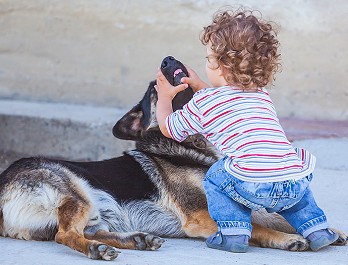
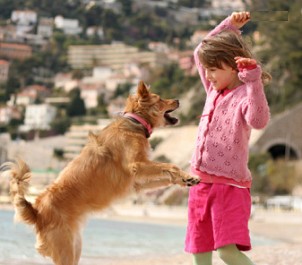
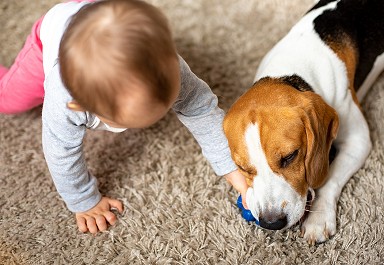
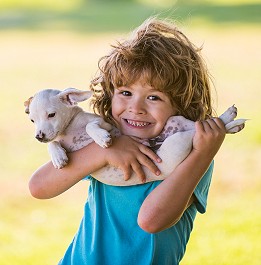
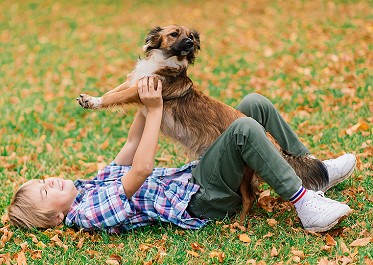
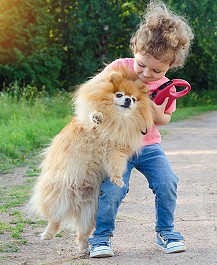
This. All of this. This is why many dog bites occur – when a child, even unintentionally, pesters or disrespects the dog. Don't allow a child to do anything like this with any dog.
You must stay in charge of your kids' behavior
It's astonishing when parents let their child engage in behaviors such as hoisting a dog into the air, squeezing a dog, holding a dog in awkward positions, trying to take a toy away from a dog, and so on.
"Oh, no worries," says Mrs. Parent. "My dog tolerates anything. He would never bite."
I'm sorry, but that's bad parenting of the child and bad leadership/guardianship of the dog. You're supposed to be the protector of both of them. That means you don't put either of them in harm's way so that they become the classic "accident waiting to happen."
Not just your child, but her friends and cousins too
My no-no list above – things children should not do with a dog – also applies to any child who visits your home. That's nieces and nephews, grandchildren, and neighborhood kids who come over to play with yours.
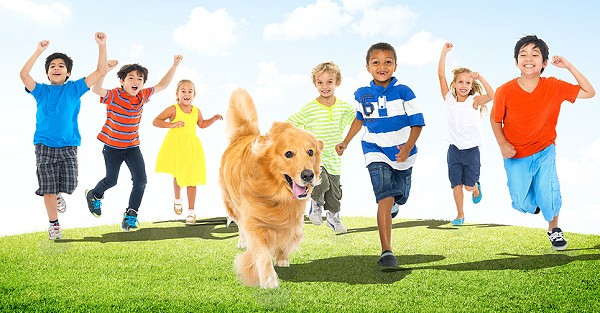
Stand up for your dog – don't let any child be rough or persistent. And stand up for the kids – don't let your dog jump on them or chase wildly after them. Children and canines must both be respectful of each other.
If any child in your home or yard won't follow your instructions about what they can and cannot do with your dog, then (1) the child needs to leave or (2) your dog needs to be put in a safe space that's off limits to the kids.
Older children and dogs
When can a child interact with a dog without supervision?
Obviously, age can't be a hard-and-fast dividing line. It would be silly to declare that a child who is 9 years and 11 months old isn't old enough.... but a child who is exactly 10 years old is!
Still, around age 10 or so is a reasonable dividing line, simply because many children around age 10 change their mannerisms and body language enough that dogs can recognize them as smaller versions of humans. This simple change in perception – by the DOG – can help decrease the incidence of dog bites.
In addition, children around this age can better understand that their own behaviors have consequences, so they're more likely to be consistent in behaving properly around dogs.
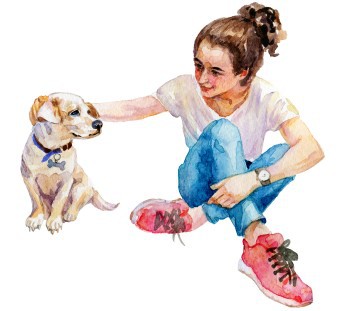
But you need to look carefully at your individual child. If your 11-year-old is still quite childish (loud, boisterous, clumsy, or likes to roughhouse), don't trust him with unsupervised canine care. Give him more time to mature.
Once kids are mature enough, they can be amazingly tuned-in to a dog and can often handle the dog better than grown-ups! Especially kids raised around animals – they might belong to a 4H club, or their parents might be farmers, ranchers, or livestock breeders. I trained my first dog when I was 11 and began participating in obedience competitions at 14.
Babies and dogs
You may have heard that "dogs instinctively know how to treat a baby gently."
Unfortunately, as a sweeping generalization that's not true. Some dogs are very gentle, yes. But many dogs are uncomfortable around babies. Dogs have attacked and killed babies, even sleeping babies.
Yet parents will pose their infants with the family dog with the infant propped against the side of the dog's head, or "riding" the dog like a pony. These parents mean well, but it shows a lack of respect for canine thought processes and canine teeth.


The body language of these dogs shows stress. The first dog is leaning as far away from the baby as he can get. The second dog has a worried expression and is licking his lips. Both these dogs are saying, "I wish I was somewhere else right now..."
Of course, ultimately it's up to you...
...how much contact you allow your dog to have with your baby. All I can tell you what's safer and what's riskier.
The safest way to have both a dog and an infant is to do everything I've recommended in this article. In addition, you should express to the dog that the baby is your possession, protected by you.
- That means at first you might not allow the dog to enter the baby's nursery.
- If he wants to accompany you to the nursery, teach him to "Wait" just outside the door.

"Good dog to wait at the door!"
- Once he is doing well with this lesson and won't enter the room, you can start giving him permission ("Okay") to come in and sniff around a bit. You want him to learn that this special room is yours and that you decide if and when he can enter.
- When he sniffs the crib or the baby's clothes, teach him that this new scent is called "Baby." Giving an infant its own word gives it a special status in the dog's eyes. "Baby. Good baby. Easy. Don't touch the baby."
If your dog doesn't know all those words, or if he knows them but only listens when he feels like it, you need to work your way through my training articles.
- Next, you can push the baby in a stroller as you also take the dog for a walk. He should walk beside you and behind the stroller, so the dog learns that he follows both of you. This is an important psychological lesson that shows the dog the new structure of the family and where he fits in the pecking order.
If you haven't yet taught your dog to walk properly on a leash so that he will stay behind the stroller, you need to work on that before walking baby and dog together.
When should you allow the dog to actually touch the baby with his nose, or lick the baby? There are no definitive answers to such questions. If your dog is calm and relaxed and you can control him at all times, you might give him the "Okay" to come closer to the baby.

This dog is leaning toward the child curiously but calmly. The child is also calm and not intruding on the dog's space. When I introduce the baby to the dog, I present the baby as a possession of mine. "Baby. Good baby. Easy!" If you repeat it often enough and your Leader-Follower relationship is solid, your dog will understand that anything claimed by the Leader must be respected and treated gently.
My best-selling books – now available FREE on my website
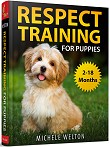 Respect Training For Puppies: 30 seconds to a calm, polite, well-behaved puppy is for puppies 2 to 18 months old. Your puppy will learn the 21 skills that all family dogs need to know. Click here to read for free.
Respect Training For Puppies: 30 seconds to a calm, polite, well-behaved puppy is for puppies 2 to 18 months old. Your puppy will learn the 21 skills that all family dogs need to know. Click here to read for free.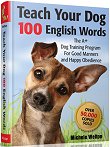 Teach Your Dog 100 English Words is a unique Vocabulary and Respect Training Program that will teach your adult dog to listen to you and do what you say. Click here to read for free.
Teach Your Dog 100 English Words is a unique Vocabulary and Respect Training Program that will teach your adult dog to listen to you and do what you say. Click here to read for free.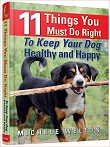 11 Things You Must Do Right To Keep Your Dog Healthy and Happy helps your dog live a longer, healthier life. Get my honest advice about all 11 Things before you bring home your new puppy, because some mistakes with early health care cannot be undone. Click here to read for free.
11 Things You Must Do Right To Keep Your Dog Healthy and Happy helps your dog live a longer, healthier life. Get my honest advice about all 11 Things before you bring home your new puppy, because some mistakes with early health care cannot be undone. Click here to read for free.
